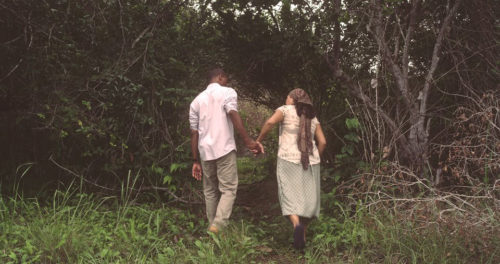Few words are spoken in Adero, the new short film from Guyanese filmmaker Kojo McPherson. The film premiered two weeks ago at the Second Timehri International Film Festival. The week-long festival was a celebration of local and regional films, some from as far back as 2012 and some like McPherson’s entry receiving their premiere this year.
The history of the 14-minute Adero (15 including the credits) dates back to 2015 when McPherson won the Immersion Prize for Best Project Idea and Pitch at the Trinidad and Tobago Film Festival in October that year. The short is steeped in magical realism and its brief running time is flooded with complex concepts. And this begins before the first real image of the film.

The film opens with a quotation, “Who looks outside dreams; who looks inwards, awakes.” It is a quote from Carl Jung, the Swiss psychiatrist and psychoanalyst. Its summation amounts to – your vision will become clear only when you can look into your own heart. And, so with two clues, we open to our first shot – a hand against the pane of a car driving away from (or is it towards?) a mountain, a man standing outside a benab, a majestic shot of a mountain, a fully dressed man lying on a plain of dirt. And then he awakens. The Jung reference is not incidental. Adero, out protagonist, has been dreaming. But, is this a dream of fantasy? Is it a memory or is it a vision?
Who knows?
Adero is less interested in giving answers or providing context than it is with creating mood. As previously mentioned, few words are spoken. McPherson explains the film initially clocked in at about 20 minutes and in shortening its running time, most of the excisions were scenes with heavy dialogue. But, it is more than the lack of consistent dialogue that provides the film with a sort of hazy, dreamy, and bewildering undertone. The invocation of Jung is more than referential. Adero is pitched like a fever dream. It is frantic, it is nonlinear and the plot seems more circular than direct, even if the frame of the main story is straightforward enough. The protagonist is looking for a priest who tended to him when he was young. He is an orphan. He claims. He lives a life that seems satisfactory, if not humdrum. The narrative’s opening, the dream, seems to have set something in motion for him. A feeling of discontent. And he visits a woman in a care home. Who is this she? Whatever her identity she seems the key to unpacking the past. Although we don’t know exactly how or why.
This lack of explanation on Adero’s part is indicative of McPherson’s interest as a filmmaker. He credits Kubrick as an influencer (more in the ever-searching 2001: A Space Odyssey mode than the satirical Dr Strangelove one). The film isn’t interested in presenting a solution. It saves Adero’s actual journey to his past for the last 30 seconds of the 14-minute running time. This seems deliberate. McPherson is privileging the road to realisation more than what comes after. In this way, the film reveals an overarching, and now decades-long, postcolonial trope of searching for oneself, for home, for identity, for purpose. A reason to be.
McPherson’s camera is his best asset here. The camera, with photography by Yaphet Jackman, is always seeking. There’s Terrence Malick’s Tree of Life quality to the narrative. McPherson’s moody camera is more confident working with tableaus and larger set-pieces than individual character beats. And, so the the film’s stronger visual moments are not in person-to-person exchanges towards the film’s climax but rather smaller moments swathed in darkness or light. Like an image of hand fumbling in the dark for a book or an almost elegiac shot of an expanse of land at the film’s end bathed in sunlight. Nature, darkness and light are as much characters in the films as the humans within the frame. They all coalesce to ask questions about identity. But there are no resolutions to be found here. This is a point McPherson acknowledges when he says the film (like life) provides no real answers, only more questions.
Composers Gavin Mendonca and Keith Waithe provide a score for the film that’s as plaintive and mournful as needed, complementing the sort of ever-searching mood the film evokes. McPherson admits to the complexity of the film, noting that he hopes to expand the concept into a feature film. It’s a model of short-film to feature film that has been a mainstay of independent filmmakers for at least two decades. In the last decade, three notable feature films (American film Whiplash, South African film District 9, Brazilian film The Way He Looks) have all found critical success with films based on shorts their directors had done. As it stands, Adero the short film might frustrate those in search of a more straightforward story, but McPherson’s film suggests a filmmaker with a clear purpose in mind: to push the boundaries of narrative and story thereby embracing the liminality of film, and of identity. Have a comment? Write to Andrew at almasydk@gmail.com.

